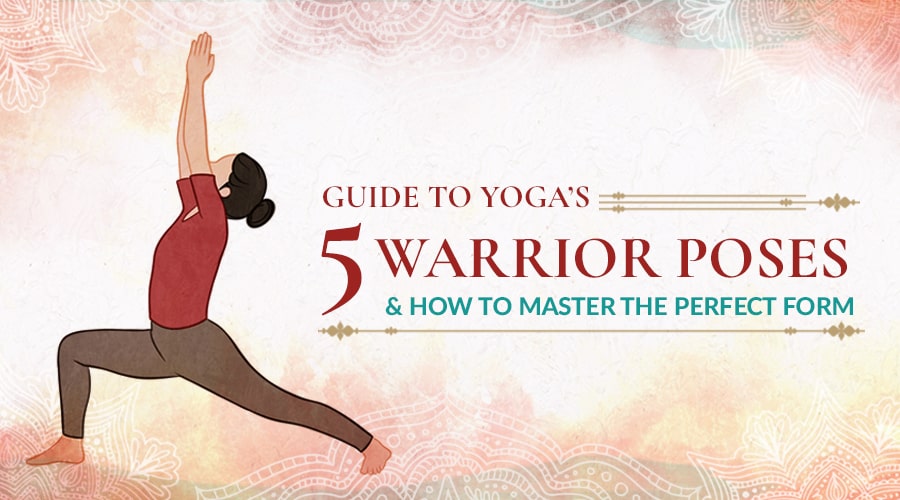The Warrior Pose, or Virabhadrasana in Sanskrit, embodies the profound power of yoga, combining strength, poise, and balance in a single asana. Inspired by the story of Virabhadra, a mighty warrior born from the hair of the god Shiva, this pose demands not only physical stability and endurance but also great mental strength and control.
Today, there are multiple variations of Virabhadrasana in yoga, each offering its own unique blend of challenges and benefits. Read on to discover the 5 core warrior yoga poses, their benefits, and how to practice each with functional form and proper alignment.
What Is Warrior Pose?
The Warrior Pose refers to a series of powerful standing yoga postures that develop strength, flexibility, and mental focus. Known as Virabhadrasana in Sanskrit, “Vira" meaning "hero" or "warrior" and "bhadra" meaning "friend", the poses are said to be inspired by the great warrior in Hindu mythology, Virabhadra.
The legend goes that the deity Shiva created Virabhadra from a lock of his hair in a fit of rage after the death of his wife. Virabhadra undergoes a series of fierce transformations, which are believed to be represented by the Warrior positions, eventually avenging the death of Shiva’s wife. The strong stances have become symbolic of the courageous energy of Virabhadra and the important role strength, courage, and focus play in overcoming challenging moments, whether it be in life or on the yoga mat.
The most common Warrior Poses found in yoga today are Warrior 1 and Warrior 2. These lunging asanas are often practiced in the beginning of a Vinyasa Flow class or during Surya Namaskar (Sun Salutation) variations. In Hatha Yoga practices, Warrior Poses are also usually practiced toward the end of the class, activating the Root Chakra and grounding us before we move on to the final relaxation.
Discover: How to Unblock Chakras: Beginner’s Guide to Chakra Meditation & Affirmations
How Many Warrior Poses Are There in Yoga?
Hatha Yoga tradition recognizes five primary Warrior Poses. The most significant are:
- Warrior I (Virabhadrasana I)
- Warrior II (Virabhadrasana II)
- Humble Warrior Pose (a forward bowing variation of Warrior 1)
- Reverse Warrior or Peaceful Warrior (a backward arching variation of Warrior 2)
- Bound Warrior Pose (a bound variation of Warrior 2 with the arms clasped behind the back and under the inner thigh)
Each of these postures is challenging in their own way, with some requiring more strength and balance than others. Keep reading for a detailed guide on how to practice these 5 key poses like a true warrior.
Mastering the 5 Warrior Poses in Yoga: Step-by-Step Guide for Proper Form & Alignment
The Warrior Poses are named after a fierce victor for a reason; they demand physical strength while maintaining mental equanimity. Remember to be conscious of your alignment and maintain control throughout each position. If you feel off balance, adjust your form using my cues below and gradually work your way up at a safe pace.
If you’re ready to sink deeper into your practice with yoga’s Warrior Poses, find a comfortable spot on your mat, take a deep breath in, gently release, and let’s begin.
Also Read - What Is A Mantra? Why Do We Use Mantras In Yoga And Its Benefits?
How to Do Warrior 1 Pose (Virabhadrasana I)
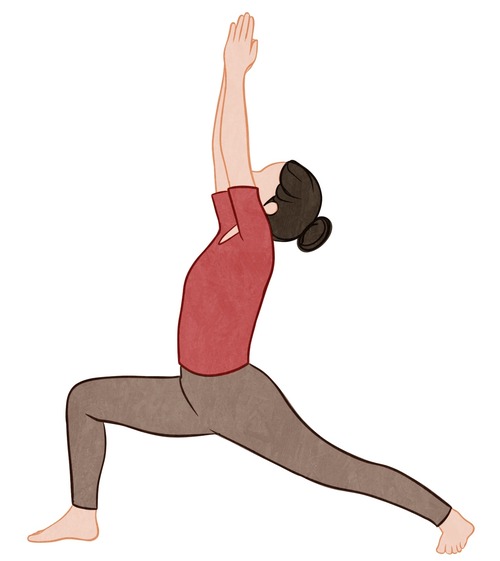
- Ground yourself on your mat with feet spread wide, roughly in line with your wrists when extended out.
- Stretch your arms out to either side, keeping them level with the ground, palms facing down, and shoulders relaxed.
- Inhale and angle your left foot slightly to the right, between 45 to 60 degrees, and point your right foot directly to the right at 90 degrees. Make sure your right heel lines up with your left.
Pro Tip: For extra stability and more ease in the pose, keep a lateral gap between your heels, about 10-20cm wide. - Exhale and twist your upper body to the right, aiming to square your hips with the front of your mat.
- Inhale and lift your arms above your head, aligning them with your forehead, and stretch upward.
- While grounding your left heel, exhale and bend your right knee, ensuring it's directly above your right ankle. Aim to have your shin vertical and, if you can, your right thigh level with the ground.
- Raise your eyes and focus on the small space formed between your hands, maintaining a steady breath.
- Hold this position for as long as it feels right.
- To come out of the pose, straighten your right knee, lower your arms, and reposition your feet to face forward. Then, repeat the pose on the opposite side.
Alignment Cues
- The kneecap of the bent leg is slightly behind or right above the center of the ankle. Keep an angle of at least 90 degrees.
- Aim to keep your hips as square as possible, while ensuring your back heel is firmly grounded into the floor.
- Press down through the outer edge of your back foot and keep your back leg straight.
- Draw your shoulder blades downward toward your waist and keep the back of your neck elongated.
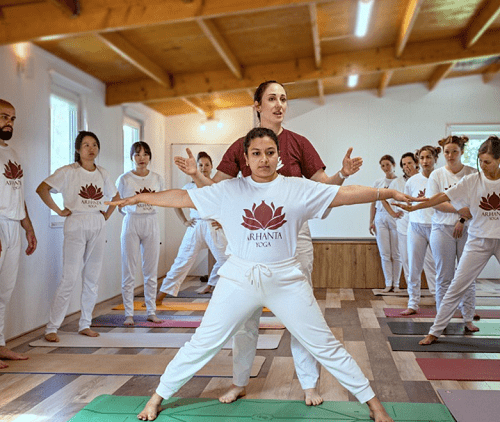
Experience authentic Hatha Yoga
Get free access to exclusive guided lessons with master teacher Kalyani Hauswirth-Jain
How to Do Humble Warrior Pose (Baddha Virabhadrasana I)
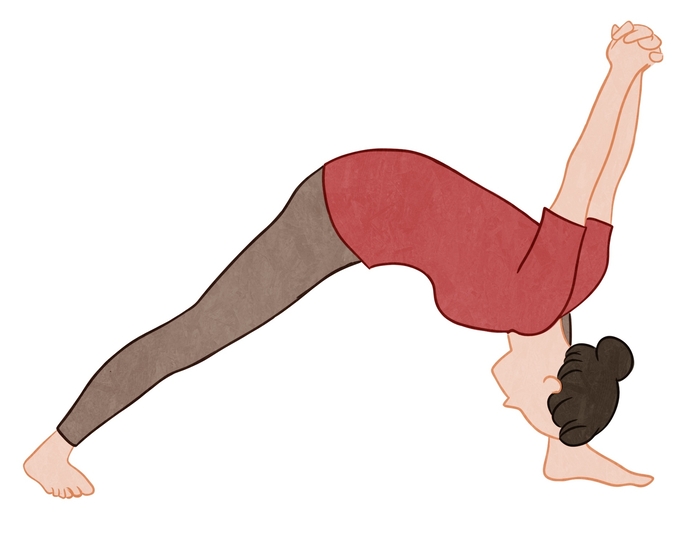
- Come into Warrior one, as explained above.
- Next, clasp your hands together behind your back and open up your chest.
- Exhale, hinging forward from the hips and guide your nose in the direction of your shin or the ankle of your leading (bent) leg.
- Lift your arms up above your head and draw the shoulders out, away from the ears. Hold the pose for as long as is comfortable, taking easy, natural breaths.
- Gently lower your arms back down and rise up when you are ready, straighten your legs, and bring your feet to the middle of your mat.
- Now, repeat on the other side.
Alignment Cues
- Ensure your feet are grounded firmly and your hips are square with the mat.
- Maintain a long spine as you hinge from your hips. Avoid rounding the back, instead aim for a feeling of length from the tailbone through the crown of the head.
- As you hinge forward, keep your neck as an extension of your spine. Direct the crown of your head toward the floor, and move your nose toward your shin or ankle, but don't strain to touch.
- Distribute your weight evenly between both feet, using your core muscles to stabilize and balance.
How to Do Warrior 2 Pose (Virabhadrasana II)
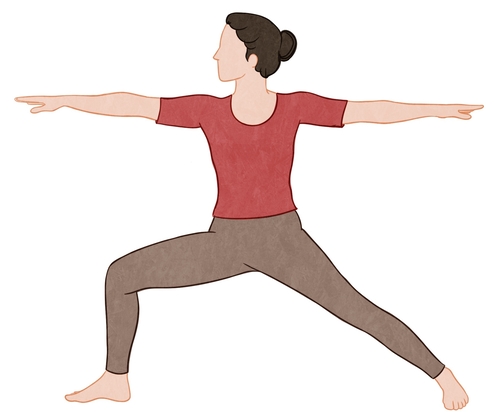
- Find a comfortable standing position on your mat, spreading your feet wide until they are in line with your arms when extended out to the sides.
- Lift your arms so they're level with the ground, stretching them to either side, with shoulder blades back and palms facing the floor.
- Keep the outer edge of your left foot parallel to the back of your mat and pivot your right foot 90 degrees to the right. Aim to align your right heel with the arch of your left foot.
- As you exhale, bend the front knee, so that it’s directly above the ankle of your front foot.
- Adjust your gaze to look over the top of your right middle finger.
- Keep your focus forward, maintain a consistent, natural breath, and hold the stance steadily for as long as it feels comfortable.
- To exit the pose, extend your right knee, lower your arms, and adjust your feet to face forward. Then, repeat on the opposite side.
Alignment Cues
- Keep your pelvis level, with both hip joints facing toward the side of your mat. Ensure the front knee doesn't tilt inward. Pro Tip: If the front knee is pulling forward, try over-crossing your stance a little. Keeping the back toes in line with your front heel can make a big difference.
- Ensure your arms are directly above your legs, stretching from one fingertip to the other with palms facing the ground.
- Your front shin should be perpendicular to the floor.
- Lower your hips, aiming to get your front thigh level with the ground. Ensure the front shin stays vertical. Widen your stance as needed to make sure that your knee does not move forward past your ankle.
- Firmly plant the outer edge of your back foot on the ground, ensuring the back leg stays straight.
How to Do Reverse Warrior Pose (Viparita Virabhadrasana II)
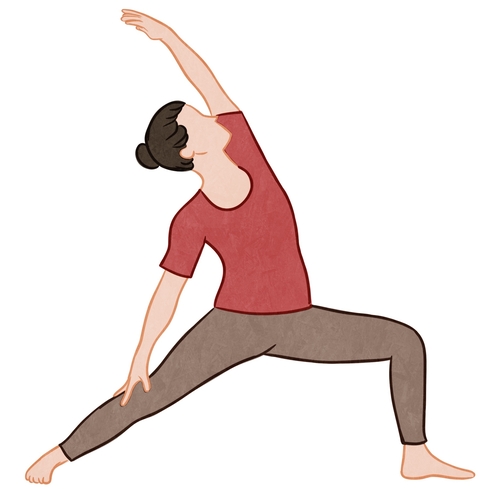
- Come into the Warrior 2 yoga pose, as described above. As you exhale, lower your left hand to rest on the back of your left leg.
- With your next inhalation, raise your right arm up and reach your fingertips high. Your right bicep should be next to your right ear. Maintain a bent front knee and keep your hips low as you lengthen through your waist.
- Allow your back hand to glide further down your leg as you gently arch your back. Angle your head a bit and direct your gaze toward your right hand’s fingertips.
- Keep your shoulders relaxed and chest lifted, stretching through the sides of your waist.
Alignment Cues
- Ensure your front knee is aligned directly over your ankle.
- Keep your hips open and squared to the side of your mat. This foundation provides stability as you move into the backbend.
- As you lift and lengthen the front side of your torso, ensure that the extension is even, avoiding compression in the lower back.
How to Do Bound Warrior Pose (Baddha Virabhadrasana II)
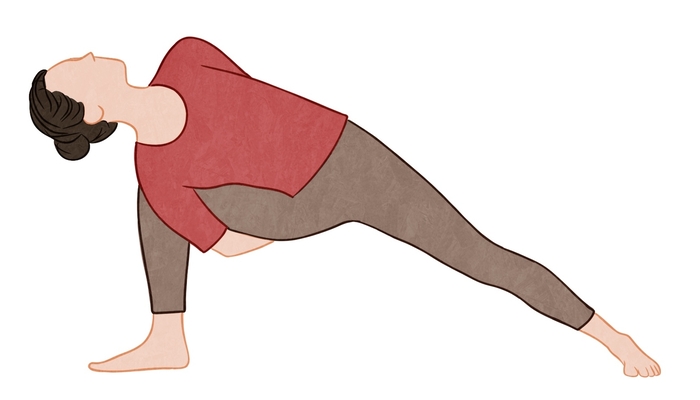
- In Warrior two, gently bring your right hand down to touch the mat, placing your right shoulder as low as you can against your right inner thigh.
- Sweep your right arm underneath your right hamstring, Then, raise your left arm straight up, fingers pointing to the ceiling.
- Bend your left elbow and guide your left arm behind you to meet and grab your right hand.
- Ensure your top shoulder remains open and lifted, avoiding a forward slump. Turn your gaze upward, looking up at the ceiling.
- Hold, and when you’re ready, release your hands, return to the center, and repeat on the other side.
Alignment Cues
- Ground both feet firmly to create a stable base. The front foot should point straight ahead, and the back foot should be positioned at about a 45-degree angle.
- As you lower your right arm, be mindful of evenly distributing weight. The touch to the mat should be light to avoid overloading the shoulder or wrist.
- Press your right shoulder into your inner thigh gently. Ensure the shoulder doesn't collapse but rather uses the thigh as a prop.
- Maintain a lifted and elongated torso. Even with the twist and reach of the arms, the focus should be on creating space between each vertebra.
When practicing this yoga warrior sequence, stay present and aware of every movement. Your body will communicate its boundaries; so, listen to the signals and adjust your form until it feels right.
Benefits of Practicing Warrior Yoga Poses
Virabhadrasana in a balanced practice can enhance lower body strength, improve balance, and increase stamina. More than this, it invites you to confront and overcome your internal obstacles, reinforcing the idea that strength is as much an internal battle as it is physical. If you're wondering how these lunging positions can bolster your overall health and well-being, here are a few notable benefits to expect:
Increases Strength & Endurance
Warrior Poses are excellent for building strength in the legs, core, and upper body. A recent study revealed that Warrior 1 & 2 were both effective in activating and developing muscles in the legs, with the potential to provide therapeutic intervention for musculoskeletal problems like chondromalacia patellae (runner’s knee).
See: Yoga for Runners: 8 Poses to Prevent Injury & Improve Performance
More than that, holding these poses engage various other muscle groups, including the hamstrings, calves, glutes, and core muscles. Regular practice can therefore increase muscle endurance, helping you hold poses for longer and with greater control.
Promotes Flexibility
Virabhadrasana, with their varied limb positions, are excellent yoga poses for flexibility in the hips, legs, and upper body. The wide lunging action opens and stretches the hip flexors, inner thighs and hamstrings, all of which are areas that become tight from prolonged sitting.
Improves Balance
If you struggle with balance, the Warrior postures provide an excellent challenge as they demand a harmonious distribution of weight across the feet while maintaining a steady gaze (or drishti). This also develops your proprioception (kinesthesia) — the body's sense of its position in space — which is essential for movement coordination and injury prevention.
Enhances Mental Focus
Inspired by the great warrior, Virabhadra, the postures encourage determination, focus, and a sense of groundedness. Holding these positions requires both physical and mental stamina, teaching us to remain calm and centered in challenging situations. Over time, this can result in increased resilience and focus in other areas of life.
Balances Energy & Emotions
Energetically, Warrior Yoga Poses activate the Root Chakra, which is responsible for our feelings of security and stability. Variations like Humble Warrior, Peaceful Warrior, and Retreating Warrior Pose also provide a deep hip opening, releasing pent-up emotions and helping practitioners let go of internal battles.
Improves Circulation & Relieves Stress
The wide stance of Virabhadrasana encourages deep, rhythmic breathing to maintain control and balance. This improved respiratory function can enhance oxygen delivery to tissues, promoting better circulation and health.
Practicing yogic breathing exercises also activates the parasympathetic nervous system which triggers the body's rest and digestion response. This causes your heart rate to slow down and muscles to relax, relieving stress and promoting calm.
Also Read - Yoga For Asthma Relief
Final Thought
When we stand firm in a Warrior Pose, we channel the resilient spirit of a fighter — grounded, yet agile; strong, yet focussed. Each variation of Virabhadrasana calls on us to face challenges with grace, to stand tall in our challenges, and to achieve a harmonious blend of focus, strength, and calm. Embracing the essence of these poses not only strengthens our physical body but also fortifies our mind, teaching us that, just like warriors, we possess the power to overcome, persevere, and thrive.

Experience authentic Hatha Yoga
Get free access to exclusive guided lessons with master teacher Kalyani Hauswirth-Jain

